HMAS SYDNEY II — FREMANTLE/ GERALDTON RESIDENCY
HMAS SYDNEY II — FREMANTLE/ GERALDTON RESIDENCY
645 Hands
This work was made during a residency at Geraldton in November 2011 (organized through Fremantle Arts Centre and the City of Geraldton-Greenough).
19 November 2011 marked the 70th anniversary of the sinking of HMAS Sydney II and HSK Kormoran in WW2. In 2007 wrecks of both vessels were located at the position and depth referred to in the title of this work. Also in 2007, my father, uncle and I were among several hundred family members who travelled to the site for a memorial service. (My paternal grandfather was one of the 645 crew lost.)
This work, made up of images I photographed over the site of the sea grave in 2007 and later transferred to paper, uses the Geraldton sun in a slow and meditative process involving cyanotype chemicals, the west coast location and a pacing between sunshine and darkness. In focusing on the process and performance of print, the work seeks to engage with the ritual of grief and remembrance through the temporal and physical relationship among memory, making and place.
While the work was on exhibition at Fremantle Arts Centre in 2012, one of the 645 pieces was lost. The postcard made to replace the missing piece connects the lost work with the true story of a Carley float beaching on Christmas Island months after the battle. Aboard that float was the body of a sailor whose identity remains unknown to this day.



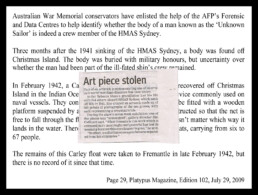
645 hands, 1350 fathoms
26° 14’ 37” S
111° 13’ 03” E
2011
cyanotype on bamboo paper
645 parts, 12 x 16cm each
overall measurement: 180 x 690cm
645 Rubbings
645 rubbings were made during a 2011 residency in Geraldton/Greenough, WA. Carnarvon is 500 km north of Geraldton. Driving into town, one passes along an avenue of honour, 645 trees planted in memory of the 645 sailors who died on board the HMAS Sydney II in 1942.
These rubbings are a companion piece to 645 hands. The landscape is flat with little growing above the horizon. Together, over two days, my dad and I walked up one side and back down the other. Walking from plaque to plaque—taking a graphite rubbing onto greaseproof paper from each—drew our attention to the ground beneath our feet, and to the tiny plants and animals living in this seemingly barren landscape.
16 hours, 2300 metres of greaseproof paper and 645 rubbings later, with sore legs from the repeated action of squatting and standing, we had performed a commemorative ritual of sorts. Not a celebration of war, and far from the tourist rubbings of famous people’s graves in Westminster Abbey, it was nevertheless a celebration of life—persisting amongst the plaques— and of loss. The residue, rolled back onto the cardboard tubes that housed the kitchen paper in the first place, fits inside a small box.





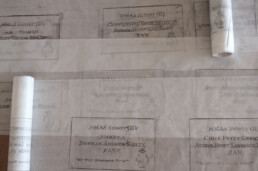
645 rubbings, Carnarvon
2011
graphite, greaseproof paper
23000 x 30 cm
AFTER VON HÜGEL — NEW HOLLAND WALKS
AFTER VON HÜGEL — NEW HOLLAND WALKS
iAIR Krems Residency — Archivi Di Quesquilia
In 2014 a residency in Lower Austria allowed me to research the Austrian botanist Karl von Hügel ‘at home’.The trip included a visit to the Herbarium at the Naturhistorisches Museum, Vienna. Here I viewed and held specimens collected by Hügel in Australia. Sitting with his specimens, I wondered where exactly he collected them. Had I walked—200 years later—on that same spot? I also reflected on the long sea voyage necessary to transport these specimens to Europe in the early 19th Century. Now Australian biosecurity laws prohibit the transport of flora and fauna and their by-products across the border except with special approval. Discarded rubbish, on the other hand, moves and is transported around the world. Archivi de Quisquilia (Archive of Rubbish), connects the human desire to collect and record with the detritus left by human consumption and activity. Archivi de Quisquilia invites participants to become the collector. By naming specimens with a scientific and common name, we mimic the language of herbarium specimens.
Supported by RMIT iAIR, AIR Krems and the Lower Austrian Government.




After Carl von Hügel Tent#1 (installed above Stein an der Donau, 2014)
Hessian, tent poles, rope, collected rubbish
Approximate dimensions: W190 x L200 x H95cm



After Carl von Hügel Tent#1 (installed at Stadtpark, Krems, 2014)
Hessian, tent poles, rope, collected rubbish
Approximate dimensions: W190 x L200 x H95cm
Horizon - Exploring the west coast with the Clipperston Project




Horizon: Exploring the West Coast with the Clipperton Project
After von Hügel: First iteration (Installation shots, Fremantle Arts Centre, 2014)
Photography: Rebecca Mansell, courtesy of Fremantle Arts Centre
Collection Pockets
Between November 1833 and October 1834, Karl von Hügel visited the newly settled colonies of the Swan River, King George Sound, Van Diemen’s Land, New South Wales and Norfolk Island. In 1994 Dymphna Clark’s edited translation of his 2000 page New Holland Journal was published. Starting in Hobart, in February 2014, I began to re-enact Hügel’s walks. With Clark’s maps to guide me, my walks are imprecise and exploratory. Hampered by the changes in the landscape over the past 180 years, I take a route shaped by fences, roads and private land. Carrying Hügel’s journal in my head, heart or hand, my imagination oscillates among what I see before me, how this place might have been and what could lie ahead.Early botanists collected voraciously, fulfilling and fuelling their own thirst for knowledge while stocking their patrons’ display cases; today our understanding of collecting and moving flora and fauna around the world is shaped by things such as conservation and endangered or feral species. Walking, in the footsteps of Hügel, provides a temporal space in which to contemplate and collect. I make accessories for walking and collecting out of fabric dyed with weeds and indigenous plants, augmented with rubbish picked up along the way. The textiles echo my footfall and perhaps reveal traces of the extended history of this passage.

After Karl Von Hügel – Collecting pockets (Hobart Rivulet Walk)
January 2014
Rubbish (plastic, metal, rope, rubber), linen and silk dyed with plants
33.5 x 51cm
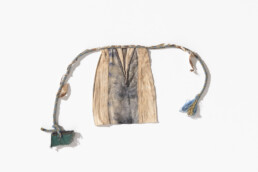
After Karl Von Hügel – Collecting pockets (Hobart Docks)
January 2014
Rubbish (rope, ribbon, vinyl), cotton dyed with plants
29 x 23.5cm

After Karl Von Hügel – Collecting pockets (Duckhole Rivulet)
January 2014
Rubbish (plastic, weedmat), cotton dyed with plants
48 x 34cm

After Karl Von Hügel – Collecting pockets (Risden Brook Dam)
January 2014
Rubbish (plastic, weedmat), cotton and silk dyed with plants
48 x 34cm
Indigofera Australis
This project has been supported by RMIT iAIR, AIR Krems and the Lower Austrian Government, UTAS (School of Art), BRAG Hill End Residency and the ANU (School of Art).
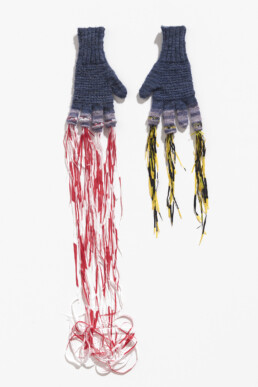
Gathering on foot between Preston and St Kilda
March 2015
Indigofera Australis dyed wool, rubbish (plastic), collected on the walk
125 x 13cm (variable)
Knitter: Rebecca Mayo

Preston to St Kilda on foot
February 2015
Plastic sack collected on the walk
70 x 51cm
Knitters: Kathlean Burton & Margaret Mayo

Preston to St Kilda on foot
February 2015
Indigofera dyed wool, plastic sack collected on the walk
43 x 23cm (variable)
Knitters: Kathlean Burton & Margaret Mayo
PRECARITY
PRECARITY
Precarity was filmed at Bababi Marning (Cooper St) grasslands, near the Merri Creek in the northern suburbs of Melbourne.
This three-in-one garment explores autonomy, control and co-operation. Printed with dye from mistletoe and eucalypt, the garment is a metaphor for the relationship between host and parasite. Traditionally perceived as destructive, the mistletoe attached to the host increases biodiversity (in the right conditions). In this work the dancers explore the potential productiveness imposed by interconnections and constraint.
Precarity
2011
Dancers: Zoe Phillips, Bronwyn Ritchie and Priscilla Manthey
Film expertise: Georgina Harper
Editing: Libby Chow
A live performance of this work was presented at the Monash Faculty Gallery during Impact7, Intersections and Counterpoints, (international multi-disciplinary printmaking conference).
In the background is Jan Hogan’s large woodblock, Becoming.
Extracting dye from mistletoe and its host (eucalypt and casuarina) in order to screenprint and dye fabric formed the starting point of this work. From here a three-in-one garment (silk chiffon and silk jersey) was constructed, each wearer connected to the next via the sleeves.
Precarity (at the Monash Faculty Gallery during Impact7, Intersections and Counterpoints)
2011
Dancers: Zoe Phillips, Bronwyn Ritchie and Priscilla Manthey
Viola: Caroline Henbest
Music: Hindu Song – Rimsky-Korsakov
FAMILY MISTLETOE
FAMILY MISTLETOE
Portrait Series
In Family Mistletoe I have raised the possibility of an alternative model to the family tree. Informed by the work of ecologist David Watson, I am interested in Australian Mistletoe and the pivotal role it plays in its natural habitats. Historically, Australian Mistletoe has been largely ignored or regarded as a menace to the trees it inhabits. However, contemporary ecological engagements with mistletoe identify it as a ‘keystone’ plant that reflects, rather than being the cause of, either a healthy or a disturbed eco-system.
Using leaves from mistletoe plants to create dyes and screenprinting inks I have printed fabrics from which I have sewn a series of six garments, each a subsequent generation from one family. These garments have then formed the props for two series of portraits. I am interested in how gender relations are reflected in historical knowledge. Like mistletoe, women are keystones, vital for the formation of the family tree, yet historically represented as incidental, perhaps even as parasites.

Maria 1802-1847
2010
UV ink on ply (dress: screenprint using mistletoe dye on cotton)
640 x 480 x 19mm

Henrietta 1851-1921
2010
UV ink on ply (shirt: screenprint using mistletoe dye on silk, Irish lace, velvet ribbon)
640 x 480 x 19mm
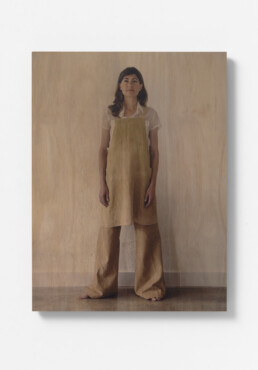
Clarice 1890-1957
2010
UV ink on ply (dress: screenprint using mistletoe dye on cotton and linen)
640 x 480 x 19mm

Janet 1915-1995
2010
UV ink on ply (nightgown: screenprint using mistletoe dye on silk)
640 x 480 x 19mm

Margaret 1945 –
2010
UV ink on ply (nightgown: screenprint using mistletoe dye on silk)
640 x 480 x 19mm

Frances 1971 –
2010
UV ink on ply (apron: mistletoe dye on linen, trousers: screenprint using mistletoe dye on hemp)
640 x 480 x 19mm
Landscape Series
The Landscape Series of portraits is the second portrait series using the mistletoe garments. Here a dancer moves within the confines of her garment. The constraints and possibilities offered by each reflect the small shifts offered to each new generation of women. Situated within a traditional photographic studio, complete with the illusion of a canvas backdrop, a constructed ‘natural’ landscape surrounds the dancer, testing the cultural meanings inherent in these environments.
Printed onto the rear face of 4mm glass, and screenprinted with gold gouache, this series uses digital printing techniques to mimic obsolete and moribund glass slide processes.
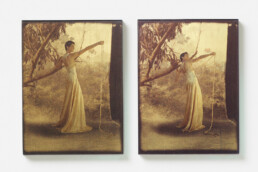
2010
Clarice 1890-1957
UV Ink and screenprint on glass, (garments: screenprinted and dyed using mistletoe dye)
16 x 12cm

2010
Maria 1802-1847
UV Ink and screenprint on glass, (garments: screenprinted and dyed using mistletoe dye)
16 x 12cm

2010
Henrietta 1851-1921
UV Ink and screenprint on glass, (garments: screenprinted and dyed using mistletoe dye)
16 x 12cm
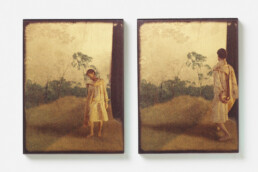
2010
Janet 1915-1995
UV Ink and screenprint on glass, (garments: screenprinted and dyed using mistletoe dye)
16 x 12cm

2010
Margaret 1945 –
UV Ink and screenprint on glass, (garments: screenprinted and dyed using mistletoe dye)
16 x 12cm

2010
Frances 1971 –
UV Ink and screenprint on glass, (garments: screenprinted and dyed using mistletoe dye)
16 x 12cm
RMIT Project Space/Spare RoomRegeneration
2010
Marian Crawford
Rebecca Mayo
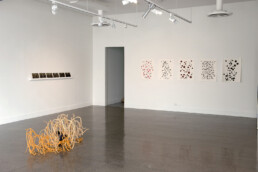
RMIT Project Space (installation view)
2010

Family Mistletoe Landscape Series
2010
UV Ink and screenprint on glass, (garments: screenprinted and dyed using mistletoe dye)
16 x 12cm

Family Mistletoe VIII
2010
Mistletoe branch, felted recycled jumpers, thread
Variable dimensions
WALKING THE MERRI
WALKING THE MERRI
In March 2012, inspired by Freya Mathews’s book, Journey to the Source of the Merri. I began a walk downstream from the source of the Merri to its confluence with the Yarra. I walked with Lesley Harding, and each day we were joined by a third walker.
The walk took seven days and became an artistic re-enactment of sorts. It was not about treading new ground, rather it set out a proposition: that I could experience the whole creek, not vicariously and fleetingly from train or car window, but by retracing the steps of all those who had walked this way before. Not just Freya and friends, Hume and Hovell or Ned Kelly, but also the countless generations of people who walked and lived in this place before colonisation.


Day Two
Wallan to Merri Park

Day Three
Merri Park to Lockerbie

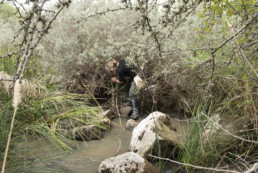
Day Four
Lockerbie to Craigieburn

Day Five
Craigieburn to Fawkner

Day Six
Fawkner to Preston
RMIT Project SpaceWalking the Merri - from source to confluence
2014
Rebecca Mayo
Roseanne Bartley
Tony Birch
Caroline Henbest
Anna Topalidou
Ilka white
Curator: Lesley Harding

Walking the Merri: From Source to Confluence (gallery view)
RMIT Project Space

Gaiters Day 3, Worn (external surface)
2013
Bidgee widgee seeds, hemp, wool, buttons, hook and eye tape, screenprinted and dyed with gorse, periwinkle, willow bark, oxalis, broom, mistletoe
48 x 40 cm each

Gaiters Day 5, Worn (internal surface)
2013
Creek water, mud, hemp, wool, buttons, hook and eye tape, screenprinted and dyed with gorse, periwinkle, willow bark, oxalis, broom, mistletoe
48 x 40 cm each

Gaiters Day 6, Worn (external surface)
2013
Ash, bidgee widgee seeds, hemp, wool, buttons, hook and eye tape, screenprinted and dyed with gorse, periwinkle, willow bark, oxalis, artichoke thistle, red gum
48 x 40 cm each

Gaiters Day 6, Worn (internal surface)
2013
Ash, hemp, wool, buttons, hook and eye tape, screenprinted and dyed with gorse, periwinkle, willow bark, oxalis, artichoke thistle, red gum
48 x 40 cm each

Gaiters Day 7, Worn (external surface)
2013
Dirt, creek water, silk, buttons, hook and eye tape, screenprinted and dyed with willow bark, oxalis, artichoke thistle, Tradescantia fluminensis
48 x 40 cm each

Seven pairs of pockets
2013
Wool, hemp, cotton, screenprinted and dyed with willow bark, oxalis, artichoke thistle, red gum, gorse, periwinkle
48 x 34 cm (approximately)

Walking the Merri: From Source to Confluence (installation view)
Catalogue and artist book

Walking the Merri: From Source to Confluence
Catalogue and artist book
Day 3.
p. 16&17

Walking the Merri: From Source to Confluence
Catalogue and artist book
p. 42&43
Ilka White
Grasses Sash and Well





